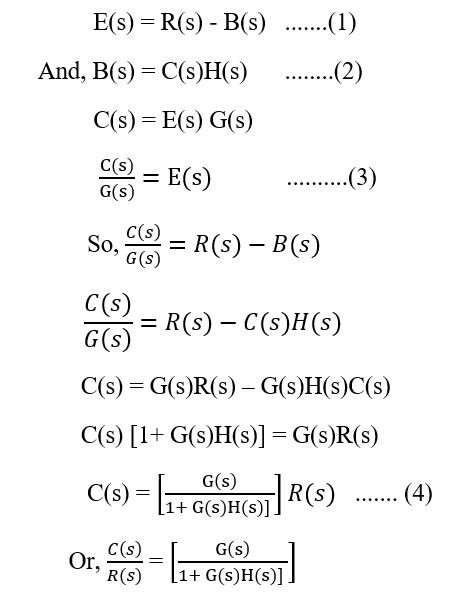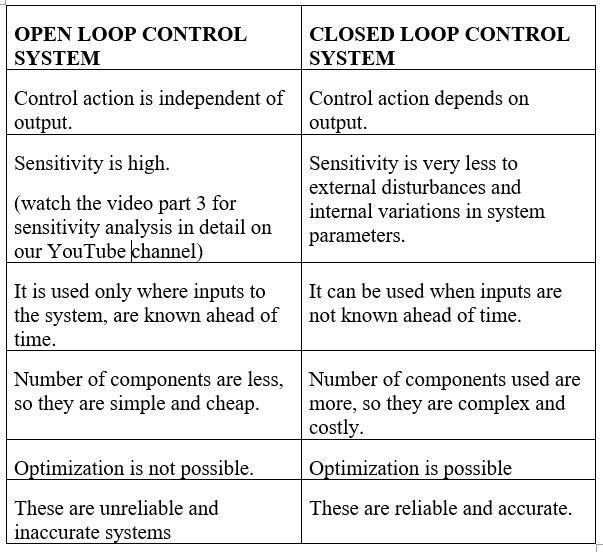In this section we will discuss about definition of control system and types of control system, also about the features of a good control system. As we all know, control system plays a very important role in our day to day to life. In electrical engineering, how a control system works? Lets start our discussion on it.
Definition
A control system is a system in which an input is given to the system and the output of the system is controlled by the help of some control elements.
You will automatically understand the meaning of a control system and it’s definition by the end of this post, but, I am giving few examples here to make the definition easier.
In a water tank the outflow of water is controlled by the tap, so the tap is the control element. Similarly, In a vehicle accelerator, brakes are the control elements to control the speed, a regulator is the control element for the fan . we will discuss the water level system in detail below.
What are the features of a good control system?
Till now we have discussed about definition of a control system, there are some characteristics or features that a control system should possess to become a good control system. We will discuss these features/characteristics in detail when we proceed in the subject, here we will see the brief meaning. These are listed below.
- Accuracy : Accuracy of a system means that how accurately the system works. It means if a system has very less error then the system will be highly accurate. So, accuracy of control system should be high or error should be less.
- Sensitivity : Sensitivity of a control system should be less; it means it should be made in such a way that it will be unaffected by external disturbances. If any disturbance comes in forward or feedback path then it should not have much effect in output of control system, so those systems which have less sensitivity are considered as good control system.
- Bandwidth : bandwidth is a range of frequencies over which a control system can work. So, to have a good control system, the bandwidth of system should be high.
- Stability : Stability of a system means, if any disturbance comes in the system then how fast the system comes in its original state. If it recovers its original state, then the system is called highly stable. And a good control system should have high stability.
- Speed : Speed of a control system should be high. We can think that a slow system is of no use, like if an electric iron takes too much time to heat up its bottom then it will be of no use.
- Oscillations : A good control system should have less oscillations. Actually, oscillations make the performance of a system poor.
TYPES OF CONTROL SYSTEM
There are two types of control system :
- Closed loop control system
- Open loop control system
CLOSED LOOP CONTROL SYSTEM
To understand closed loop control system, we will take the example of water level indicator. First see the figure below

In this example, we have a task that we must maintain the water level at a desired height (say 5m). This 5m value is the input (or set point) to the automatic controller, it means that automatic controller will compare the new height with this set point. A level transducer is placed in the tank to measure the current height of water in the tank, this level transducer is connected with automatic controller, now the value(new height or output) given by the level transducer is compared with the set point(input) by the comparator.
If the new height is more than the set point then the automatic controller will control the control element and opens it, so that the water can flow from the outlet and water level will decreases to desired height again.
If the new height is less than the set point then the automatic controller controls the control element(tap) and closes it, so that water level will increase in the tank and we get the desired output.
Now, to make the relation between input and output we will arrange this system in a block view, see the block diagram below,
block diagram representation

By the above explanation we will construct this block diagram in steps below.
- R(s) or set point = input to the comparator
- E(s) =error signal which is the difference of input and reading of level transducer (B(S).
- Automatic controller, control element, and plant (inlet, outlet, tank, water) are connected in such a way that they give the output ‘H’, all these are combinedly known as Forward path of the system.
- Level transducer is connected in such a way that it will read the value ‘H’ and gives to the comparator. Hence it is known as Feedback path of a system.
In short, we can say that due to feedback system and the automatic controller, the upper system is a closed loop system as we just have to give the set point and the system will automatically gives the desired results.
We can also modify the bock diagram as given below in which
G(s) = forward path gain
H(s) = feedback path gain
R(s) = input
C(s) = output
B(s) = feedback signal
E(s) = error signal

or we can also make the above diagram in mathematical form as shown below,
mathematical representation


Examples; automatic washing machine, water level controller, automatic electric iron, automatic traffic light system etc.
This is called transfer function of a closed loop system.
OPEN LOOP CONTROL SYSTEM
we will take the same example to understand open loop control system,
In open loop control system, the feedback is not connected with the automatic controller, it does not mean at all that the level transducer or sensor or feedback is not present in the open loop control system, it is just not connected with the automatic controller as shown in the figure below.

The level transducer is connected with the display, it means if there is a deviation in the height of water in tank then level transducer will note it and send this reading to the display. But, as we can see that there is no feedback value coming to the automatic controller hence, it is unaware of the new height, it did not know that the new height is more than the required or less or equal, Therefore, it can not change the control element position.
Yes, by seeing the display reading, we can manually change the tap position to control the flow or to maintain the height of water. Similarly, You can also think of other examples such as room heater without temperature sensor, water boiling system, normal traffic light system( display is connected to show the timing only, it will not change the timings of lights according to the traffic flow) etc.
block diagram representation

So, E(s) = R(s)
And B(s) is proportional to C(s).
The above model can also be shown like this

Hence this is all about a open loop control system.
DIFFERENCE BETWEEN OPEN LOOP AND CLOSED LOOP CONTROL SYSTEM

with the help of above table you can also write the advantages and disadvantages of both types accordingly.
In conclusion,I would like to tell you that, we have discussed the basic of control system and types of control system also features of a good control system in this post, if you have still any doubt then please watch our video .
I am doing a lot of hard work to create these posts, so if you like my work then please comment here and check out our other posts also, we will discuss about Transfer function in the next post. Goodbye take care.
